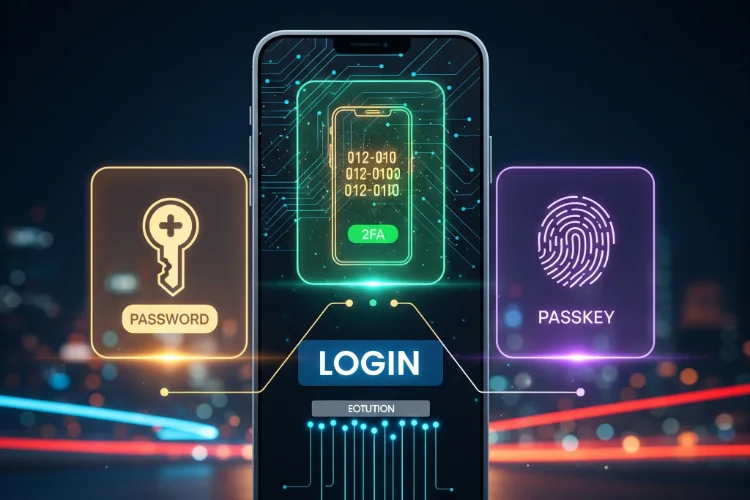In our previous posts, we discussed the inherent weaknesses of traditional passwords and why a password manager is a non-negotiable tool for generating and storing strong, unique credentials. However, even the strongest password, meticulously stored in a password manager, can still be vulnerable to sophisticated attacks like phishing or if your master password is compromised.
This is why modern digital security has moved beyond passwords. The industry’s leading standard for protecting your most critical accounts is multi-factor authentication (MFA). MFA requires you to prove your identity using two or more different “factors” of authentication.
This isn’t about complexity; it’s about layering your defenses. This guide will simplify the often-confusing world of authenticators, passkeys, and 2FA (Two-Factor Authentication), explaining what they are, how they work, and why they are essential for safeguarding your business in today’s digital landscape.
The Foundation: Understanding Multi-Factor Authentication (MFA) and 2FA
Let’s start with the basics.
Multi-Factor Authentication (MFA) is a security system that requires more than one method of verification from independent categories of credentials to verify the user’s identity for a login or other transaction. The “factors” generally fall into three categories:
- Something you know: (e.g., a password, a PIN, a security question)
- Something you have: (e.g., a physical token, a smartphone, a hardware key)
- Something you are: (e.g., a fingerprint, facial scan, retina scan – biometrics)
Two-Factor Authentication (2FA) is simply a specific type of MFA that requires two of these factors. For example, your password (something you know) plus a code from your phone (something you have).
The power of MFA and 2FA is that even if a hacker steals your password, they still need the second factor—something they don’t have or aren’t—to gain access. This makes your accounts exponentially more difficult to compromise.
Your Second Layer of Defense: Exploring Authenticators and 2FA Methods
When you enable 2FA on an account, you’ll typically be presented with several options for your second factor. Here are the most common ones, along with their pros and cons:
1. SMS Text Message Codes (Least Secure)
- How it works: After entering your password, a code is sent to your registered phone number via SMS. You enter this code to log in.
- Pros: Very easy to set up and use; widely supported.
- Cons: Least secure 2FA method. SMS messages can be intercepted (SIM-swapping attacks), and phone numbers can be ported to new devices by malicious actors. While better than no 2FA, it’s generally not recommended for high-value accounts.
2. Email Codes (Not Recommended)
- How it works: Similar to SMS, a code is sent to your registered email address.
- Pros: Easy to set up.
- Cons: Very insecure. If your email account is compromised (which is often the first target for hackers), the second factor is also compromised. Avoid using email for 2FA on other accounts.
3. Authenticator Apps (Strong & Recommended)
- How it works: These are smartphone apps (like Google Authenticator, Microsoft Authenticator, Authy, or LastPass Authenticator) that generate time-based one-time passwords (TOTP) that change every 30-60 seconds. You link your account once by scanning a QR code, and then the app generates the codes locally, even without an internet connection.
- Pros: Much stronger than SMS. The codes are generated on your device and are not transmitted over an insecure network. They are also resistant to phishing because the code is tied to your device, not a communication channel.
- Cons: If you lose your phone without a backup of your authenticator app data, you could be locked out. Always ensure you have backup codes or a recovery method set up.
- Examples: Google Authenticator, Microsoft Authenticator
4. Hardware Security Keys (Strongest & Highly Recommended)
- How it works: These are physical devices (like a YubiKey) that plug into a USB port or connect via NFC/Bluetooth. After entering your password, you simply touch or tap the key to authenticate. They use the FIDO (Fast IDentity Online) standard.
- Pros: The most secure form of 2FA. They are almost entirely phishing-resistant because they rely on cryptographic keys, not codes that can be stolen or intercepted. They offer excellent protection against sophisticated attacks.
- Cons: Requires purchasing a physical device; can be inconvenient if you forget your key.
- Examples: YubiKey, Google Titan Security Key
The Future is Passwordless: What Are Passkeys?
The biggest evolution in authentication is the rise of passkeys. This is a relatively new, highly secure, and user-friendly way to log in to websites and apps that aims to eventually replace passwords entirely.
- How it works: A passkey is a digital credential that is stored on your device (like your smartphone, laptop, or tablet) and uses biometrics (fingerprint, face ID) or a PIN to authenticate you. Instead of typing a password, you simply confirm your identity on your device. The passkey itself is a cryptographic key that securely verifies your identity to the website.
- Pros:
- Extremely Secure: Resistant to phishing, credential stuffing, and most other password-based attacks. Passkeys are built on the same FIDO standards as hardware security keys.
- Easy to Use: No passwords to remember or type. Just a quick fingerprint, face scan, or PIN confirmation.
- Device Syncing: Many passkey implementations allow your passkeys to sync across your devices (e.g., Apple Keychain, Google Password Manager), so if you set one up on your phone, you can use it on your laptop.
- Cons: Not yet universally supported by all websites and applications, though adoption is growing rapidly. You are tied to your device ecosystem (e.g., Apple, Google).
- Examples: Apple Passkeys, Google Passkeys, Windows Hello. Learn more about passkeys from The FIDO Alliance.
Passkeys represent a significant leap forward in digital security, combining top-tier protection with unparalleled user convenience. Many major services like Google, Apple, and Microsoft are actively promoting their use.
Why Your Business Needs These Layers of Protection
For business owners, enabling authenticators, passkeys, and 2FA on your accounts isn’t just a recommendation; it’s a critical component of your Web Security & Hardening strategy.
- Protect Critical Business Assets: Your WordPress Development admin login, your E-commerce platform, banking portals, cloud storage, social media accounts—these are all high-value targets for hackers. 2FA acts as a barrier, even if your password is stolen.
- Safeguard Customer Data: If your systems are breached due to weak authentication, your customers’ personal and financial data is at risk. This can lead to devastating legal consequences, fines, and irreparable damage to your brand reputation.
- Comply with Regulations: Many industry regulations and best practices increasingly recommend or require MFA for access to sensitive systems.
- Build Trust: Demonstrating a commitment to strong security builds trust with your customers and partners.
Our Web Security & Hardening services at Rudtek always include implementing robust authentication methods to protect your most valuable digital assets. We guide our clients through setting up strong 2FA for their Hosting accounts, WordPress dashboards, and other critical services.
What’s Next?
Understanding and implementing these multi-layered authentication methods is a significant step toward a truly secure digital posture for your business. You’re no longer just relying on a single, fallible password.
In our final blog post in this series, we’ll dive into the art of making a secure password – covering issues with weak passwords, how to use password generators effectively, and quick, memorable ways to create passwords that even a password manager would be proud of.
In the meantime, we’d love to hear from you.
- Which 2FA method do you currently use (or plan to use) for your most important accounts?
- What’s your biggest takeaway from learning about passkeys?
- What’s one account you’re going to enable 2FA on today?
Share your thoughts in the comments below! If you need expert assistance in securing your business website or implementing a comprehensive digital security strategy, don’t hesitate to contact Rudtek today. We’re here to ensure your online assets are protected against the evolving threat landscape.







